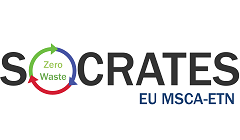
My name is Samant Nagraj and I am the ESR 3 from India. I am an introvert and a night owl. I can spend days watching YouTube, movies, sitcoms and Japanese anime. I am not a great cook, but I like to cook when I get bored.
I have a bachelor’s degree in Mechanical Engineering from JNTU Hyderabad, India. Working on my bachelor thesis at a steel plant made me realized how amazing Metallurgy truly is. So, I decided to do master’s in Metallurgical Engineering and the research at RWTH Aachen University, Germany caught my interest. At RWTH Aachen, I focused my study on Process Technology of Metals and wrote my thesis on electronic scrap recycling. I am currently enrolled at KU Leuven, where I am undertaking a PhD with the focus on the valorization of fayalitic slag.
My PhD is about designing highly selective pyrometallurgical process for the extraction of metals from industrial-waste residues such as metallurgical slag. This process produces an ultra-clean slag which can be further valorized as a building material. My host company Metallo is utilizing plasma gas to selectively separate Zinc from the fayalitic slag. My job is to study the effects of plasma gas submerged in the liquid fayalitic slag on the Zinc extraction process. I have to develop a model to calculate the reaction rates and equilibria for the zinc-fuming reaction and validate it.
I want to develop novel recycling techniques and processes with cutting edge technologies which produce zero waste. For that reason, I have to become an experienced researcher in process metallurgy and metal recycling. In the distant future, I want to start a metal recycling company using the experience I gained. I believe KU Leuven and Metallo are the right places for me to learn and develop my skills as a researcher. Prof. Blanpain and Ir. Chintinne are sharing their experiences and guiding me in the right direction to achieve my goal.
If you are interested in my research topic, do not be hesitate and get in touch with me, I will be glad of talking and discussing about it. You can contact me at: samant.nagraj@metallo.com
Problem statement and objectives
Fayalite slags produced from secondary copper smelting contain a considerable amount of ZnO. Valorising the ZnO is helpful in achieving a circular economy. To this purpose, slags can be treated using the slag fuming process, where the volatile metals such as Zn and Pb are evaporated from the molten slag bath. The final slag with very low Zn and Pb becomes a valuable mineral product in the cement industries, enabling true circular economy. A conventional zinc fuming process involves a pressurised injection of the pulverised coal and the air into the reactor, which heats the molten slag bath using the energy produced from combustion and reduces the ZnO using the combustion gases. However, a significant amount of fossil fuel is used in this process, emitting a considerable amount of greenhouse gases. To reduce the emissions and to utilise the fossil fuel more efficiently, a new fuming technology has been developed where the function of fossil fuel is decoupled by replacing fossil fuel burners with electrically powered non-transferred arc plasma torches which is the energy source for the process, and petroleum-coke pellets are used for the reduction of ZnO which are introduced from a feeding hole at the top of the reactor. A process intensification is also achieved due to the high flame temperature of the plasma. The objectives of the PhD are to (1) develop a process model of a submerged plasma zinc fuming process and validate it with the plasma fumer at Metallo Belgium, and (2) to optimise the process parameters to achieve metal extraction at the lowest (economic and ecological) cost.
Methods
Metallo’s submerged plasma zinc fuming process is a batch process with several complex interactions between petcoke-slag, gas-slag and petcoke-gas (Figure 15). Therefore, the conditions in the reactor change with time. Modelling these interactions and fitting results with the reality would be challenging without making assumptions and simplifications. Therefore, a process model of Metallo’s submerged plasma zinc fuming process is developed using a dynamic flowsheet-modelling approach with FactSage 7.0’s macro processing. This approach allows to model these complex interactions and determine the changes in process conditions with time. FactSage databases FactPS, FToxid and FTmisc were used to calculate thermodynamic equilibrium. Each sub-unit of the process is connected by streams of heat and mass; the heat and mass transfer to the subsequent zones are assumed only after attaining the thermodynamic equilibrium. The heat supplied and lost in each sub-unit operation were also taken into account. Microsoft Excel was used as a user interface to set up the initial conditions for the simulations and to write the results.
Results obtained
Two scenarios were simulated using the model to understand the rate-limiting factors of the fuming process. In the first scenario, it is assumed that the process happens at thermodynamic equilibrium, and there are no kinetic factors affecting the process. In the second scenario, it is assumed that the process is affected by kinetic factors. From the literature, it is known that the tuyere gas can partially bypass the slag bath, and it is not in thermal equilibrium. Therefore, the parameter tuyere gas efficiency, which is the amount of tuyere gas in equilibrium with the slag bath, is used to fit the calculated ZnO content with the measured ZnO content in the slag. The data for the simulations were taken from Metallo’s process database.
From the simulations, it was found that Metallo’s fuming process does not happen at thermodynamic equilibrium. The tuyere gas indeed partially bypasses the slag bath, and the amount of gas bypass predicted by the model was in close agreement with the previous studies which is approximately 15%. Moreover, the model predicted the process parameters such as final slag bath temperature, ZnO content of the slag and the total amount of ZnO dust collected at the end of the process which is in close agreement with the industrial measurements. However, in some simulations, the model predicted an abnormal amount of tuyere gas bypass. The causes of these abnormal predictions must be further studied to have a consistent model.
Conclusion and future work
A dynamic process model of submerged plasma zinc fuming process is developed in FactSage 7.0 based on the industrial scale fuming furnace at Metallo Belgium. Several batches of industrial slag fuming have been simulated using the model. A kinetic parameter called tuyere gas bypass is assumed in the model to fit with the reality. The model predicted the process parameters such as final slag bath temperature, ZnO content of the slag and the total amount of ZnO dust collected at the end of the process in close agreement with the industrial measurements. However, in some batches, the model predicted an abnormal amount of tuyere gas bypass. This abnormality will be explained by studying the correlation between the slag properties and the tuyere gas bypass.


